





There are several plant species that are called Christmas cacti, but the true Christmas cactus is the plant discussed below, Schlumbergera x buckleyi, a hybrid of some very similar holiday cacti, and is a very common plant in cultivation. These are relatively easy plants to take care of, safe (no spines or toxins) and can live a long time (generations). The following is a brief discussion of these plants and their year round care.
Natural History:
The true scientific name for this plant is a bit unclear. In PlantFiles, these are entered under both Schlumbergera truncata as well as Schlumbergera x buckleyi. It appears that the ‘true’ Christmas cacti are indeed hybrids of S. buckleyi and possibly S. truncata. Some call this plant a Zygocactus species, but that is definitely a synonym genus, not a currently accepted one for this species. Closely related plants include the Thanksgiving Cactus (again, due to the timing of the plant’s natural affinity to bloom around Thanksgiving) or Crab Cactus, (due to the overall shape of the plant) and Easter cacti. These plants are nearly identical to Christmas cacti but tend to either have sharper node tips, or much blunter node tips and bloom at different times of the year.
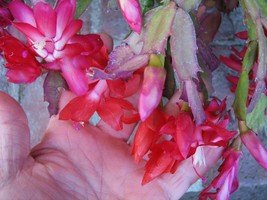 flowers coming from tips of branches
flowers coming from tips of branches
Schlumbergeras are epiphytes in nature (grow on other plants or non-soil surfaces), from the high elevation jungles of Brazil. Their natural environment is a relatively cool even temperature, high humidity, bright light with little direct sunlight, and frequent rain. Considering their tropical source and epiphytic nature, however, they do amazingly well as potted plants in normal cactus soil and in a warm temperate climate, or indoors.
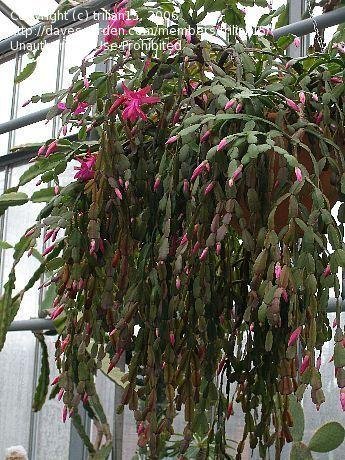
A particularly large and old plant- these do well as hanging plants thanks to their epiphytic nature (photo by trilian15)
Though these are indeed true cacti, they do not look like the cacti most are normally used to seeing. These plants are fleshy, green, segmented plants that, over time, develop woody, thick stems. Thankfully they are basically spineless (aka 'user-friendly'). They also have no leaves, though some sources refer to the segments as cladophylls, or a form of leaf. However, the segments are usually called cladodes and are similar in general form to those that make up Opuntia cacti. Flowers develop in fall from the tips of the last cladode of each segmented arm.
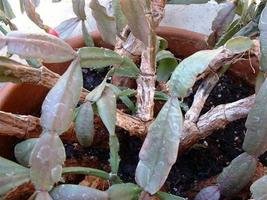 old plant with woody stem (photo by pdb George4tax)
old plant with woody stem (photo by pdb George4tax)
Care:
Not surprisingly, Christmas cacti require different care than do most cacti. Though from the tropics, they live in a relatively cool environment and therefore do NOT like high heat like most cacti do. Basically all cacti are summer growers and spend winter basically comatose or at least very inactive in terms of growing or flowering. And this is still true of Christmas cacti, despite their blooming in winter. They do very little growing in winter, but it is the best time of year to enjoy Christmas cacti, when the days are shortening and the temps cooling down. They don’t like temps much over 80F anyway. On the other hand they cannot tolerate freezes either, and prefer temps above 55F (though outdoor plants seem to cope with temps into the low 30s well- just not very happy about them). So if keeping them outdoors and cold weather is coming, it’s time to bring them in.
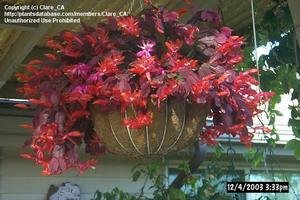 photo by Clare_CA
photo by Clare_CA
note the color change of leaves in winter, due to cold on this outdoor plant
And unlike most cacti, Schlumbergeras do not like full sun, particularly when it’s hot. But they do like bright light and grow and flower best if the light is very bright. Fortunately they do tolerate low light situations for short periods of time, and that is why they do so well as indoor plants. A few days in the middle of the table far from windows will not do them much harm… but they do need to be returned to an area of bright light soon after, or blooming might cease early. For those in cold climates, these cacti do best if kept outdoors under a shady tree or porch when it’s warm and moved back indoors near a bright window as it gets colder. In warmer climates these can be kept outdoors year round, but still don’t try to grow them in the garden like one would a regular cactus. I have tried this over and over unsuccessfully, though I can sometimes get them to grow in raised beds on the north side of a house if watered well all year round. Freezes will damage them, but it takes a pretty severe freeze in southern California to kill one.
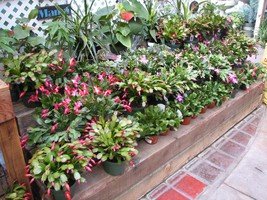
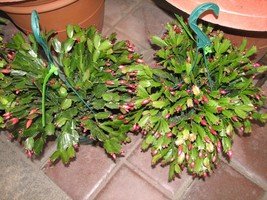
These are sale plants in a nursery in low light. There were probably greenhouse plants until just recently. Note the buds on the plant in second photo. Perhaps this one will still be blooming around Christmas, but as this is November, it may not be. Best to get a brand new plant a week before Christmas if you want to be blooming then.
They still are cacti, though, and need to be planted in well draining soil. Remember that in the wild they basically live in soilless situations, so water needs to drain past the roots easily, or they could rot. I have personally found that they do not rot all that easily, though, and some carelessness about watering is tolerated. But certainly not recommended! Underwatering will kill a Christmas Cactus, too, but a lot more slowly. There is plenty of time to intervene should the cladodes appear flattened and wrinkled. Schlumbergeras are from high rainfall and high humidity environments and do appreciate being watered regularly. These plants tend to do well in soils with a good portion of peat moss, something that, if it dries out, will be hard to get wet again. So be careful not to let soils get too dry if using peat moss. Use clay pots if growing these in humid climates, and plastic pots if growing in arid climates. Leach the soil 2-3x a year of accumulated salts.
Once the days shorten (usually in October), back off on watering. Some recommend NO water the entire month of October, and then resume again in November. Then it is recommended to withhold water again once blooming is over for a bit longer than a month this time. If signs of new growth appear, it’s time to start watering again. This is also a good time to repot the plant and put it in some new, clean, well draining soil. Repotting is recommended every few years.
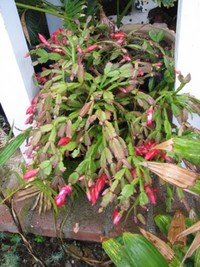
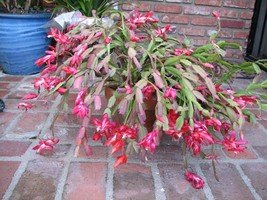
First photo is of my outdoor plant on Thanksgiving, and then a week later.
Fertilization should be with half strength water soluble formulas and only in warmer weather (not during or after flowering, until new growth is seen and time for repotting). If using a granular fertilizer, it is best to be stingy- these plants do tolerate fertilizers better than do most cacti, but still, be careful. 10-10-10 is the best ratio to use.
For plants that are not flowering as expected, be sure the soil is not too dry, or plants are not next to a cold or hot source (air conditioner, heater etc.). If there is some night light on the plant, it might retard it from blooming well. Put these plants in a totally dark room for a minimum of 13 hours a night. This will also help these plants bloom when wanted, and not too early (like around Thanksgiving which is probably more ‘normal’ for most plants). These plants may need longer light to simulate early fall, rather than late fall, to keep them from blooming too early. Then do the total darkness thing about 4-6 weeks before the time blooming is desired, every night until buds form and the plants can be returned to their location near the window or table. And be sure the daytime temps are in the 60s (hot houses will prevent these from blooming) and night temps are not much below 50F. Sometimes a little liquid fertilizer with extra potassium can help stimulate blooming. Once flowering starts, it is recommended not to move these plants too much, in terms of overall heat and light, or they may abruptly stop blooming and drop all their buds.
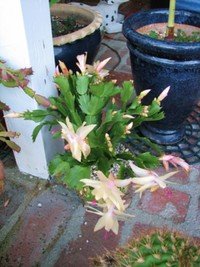
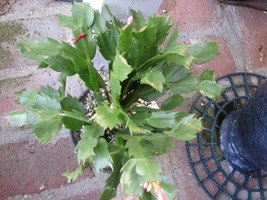
My plant right from the seller in photo on left above, where it has been kept indoors and happy, to outdoor life on the right- note all the blooms fell off and hardly any flowering, despite only being a week later- went into shock from the change of environment
Problem insects include fungus gnats, mealy bug and scale. The first one can often be controlled by simple insecticidal soap and trying not to keep the soils too wet. The other two usually need systemic insecticides, particularly scale, and can really damage a Christmas Cactus in a hurry. Plants kept in areas where there is good air circulation (such as hanging outdoors under a tree) usually have less problems with insects.
Pruning of plants once the flowering season is over is a good way to make the plants bushier or fuller. This also provides one with a number of cuttings for making more plants.
These are pretty easy plants to propagate, by just taking cuttings of 1-4 cladodes long and letting them sit in a cool dry place for 2-3 days, then planting them in a pumice or well draining soil/germinating mix until new growth is seen. Water only sparingly at first, but once roots form or new growth is seen, water regularly. It is best to do this when it’s warm, but possible to do just about any time of year.
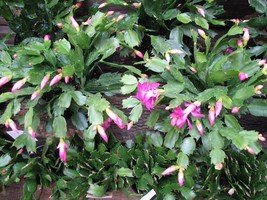
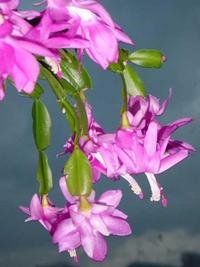
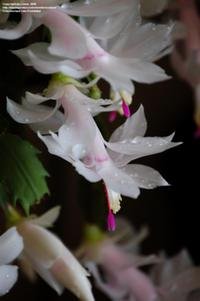
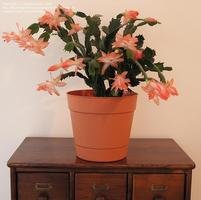
These plants come in a variety of colors now as hybridization practices become more refined. Photos from left to right: mine, pdb_vince, jnana and Grasmussen
These are long lived plants and if taken well care of, repotted regularly and keep from rotting or drying out too much, they can become fairly large, woody-based plants and become family heirlooms for generations.
The following link is to a site which is the best I have seen for explaining the differences between Christmas Cacti, Thanksgiving Cacti and Easter Cacti:
http://cactus.biology.dal.ca/paulS/christmas/christmas.html#christmas
(Editor's Note: This article was originally published on December 23, 2007. Your comments are welcome, but please be aware that authors of previously published articles may not be able to promptly respond to new questions or comments.)
Copyright © www.100flowers.win Botanic Garden All Rights Reserved